Are you a thread parker? I am!
Parking your embroidery threads is a great way to save time and thread. If you’re not sure what “parking” means, I’ll show you!
Thread parking varies from project to project. On some projects, you might not need to park your threads. On other projects – especially projects that involve a lot of color packed into a small space (think needlepainting projects, very complex cross stitch projects, and the like) – you might have anywhere from two to a dozen or more threads parked at a time.
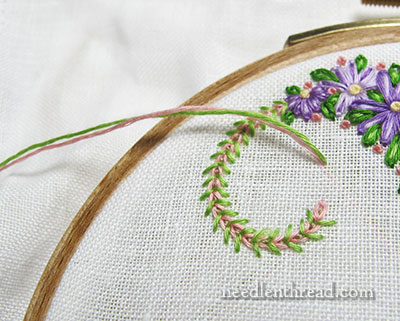
Here’s a shot of two parked embroidery threads on one of my letters from the Stitch Sampler Floral Alphabet I just finished.
Because I’m not finished just yet with the pink and green in that area of stitching, I’ve “parked” the threads by bringing them to the front of the fabric slightly away from the stitching area, to await the next time I need those two colors in that area. I didn’t end the threads, because I planned to use the same colors along that line to work some accent stitches.
Because I’m working on a relatively open weave piece of linen here, I can park my threads anywhere on the design area and they won’t leave a hole. But if you’re working on a tightly woven fabric, or any kind of silk or satin or solidly woven cotton where bringing your threads through the fabric like this might leave an open hole, you have to park your threads outside the design area.
The idea is to bring them to the front of the fabric in a spot that 1. won’t leave a hole within the design area; 2. won’t interfere with your other stitching; and 3. where you are aware that they are there (as opposed to parking them from the back of the work, where you can’t see the threads – this could result in a real mess on the back of the work!).
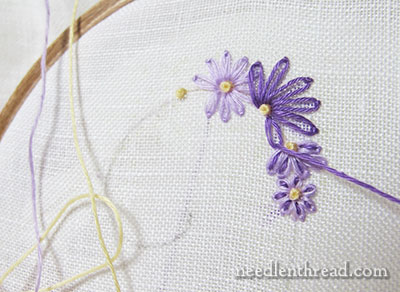
In the photo above, at this point, I’m working with three colors – a light purple, a dark purple, and a pale yellow. When the photo was taken, I was stitching with the dark purple, and I had already stitched in the yellow French knots and some light purple petals.
Because I knew I would use the light purple and the yellow again in that area, I didn’t want to end the threads. But I wanted to work in the dark purple petals and accents before I went back to the light purple and the light yellow.
So instead of ending the light purple and yellow threads, I brought them to the front of my work, away from the stitching area in a direction that wouldn’t interfere with my stitching.
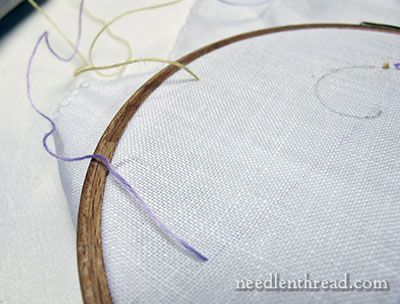
Here, you can see them “parked” off to the side, away from the stitching area. To keep them out of the way, you can wrap them in a small loop and lay them against the fabric, or just leave them dangling, as long as you’re aware of them and you’re certain they won’t get caught up in your stitching.
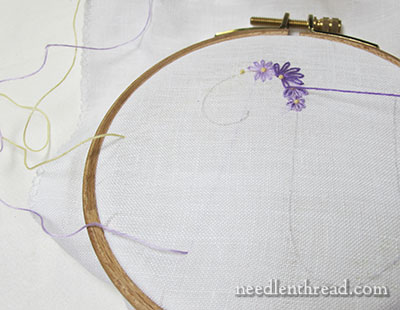
Here, you can see the parked threads in relation to the work.
I use this time-saving technique in embroidery any time I’m using multiple colors of thread in a small area. There’s no point in ending the threads if I’m going to use them again, so I just park them until I need them again. As long as I know I won’t need to carry the thread a long distance across the back or across an open space of fabric (in a way that the thread would show through), I can go back to the thread and use it again without finishing off and re-starting it.
Using a Needle Minder
Some embroiderers use needle minders or magnets to help them park threads. If you leave each thread threaded in a needle, you can park your thread by bringing it to the front (again, out of the design area if you fear a noticeable hole would be left in the fabric) and rest the needle on a magnetized needle minder (or even just poke the needle into the fabric, as long as you’re certain the needle won’t get in the way of your hand).
This saves even more time, because you don’t have to re-thread your needle each time you change threads, but it requires multiple needles. If you’re working with a dozen colors, this can be a little problematic.
Avoid Chaos with Threads!
I find it easier, though, to park needles and threads as spread out as possible around the outside edge of my work area.
If the threads are all bunched up around one needle minder, it’s easier for chaos to ensue, so parking my threads farther apart (sort of fanning them out along the edge of the work) works better for me. But, again, it all depends on the number of threads you’re using and on your own personal stitching techniques and preferences.
So, what about you? Are you a thread parker? If so, how do you go about parking them? Do you use a needle minder, or do you just bring them to the front of the fabric out of the way? Do you leave the needle on, or take it off? Any tips to share? Have your say below!
Stitch Sampler Alphabet
The project featured in the above photos is from my e-book, Stitch Sampler Alphabet. It’s a fun, beautiful, and quick way to learn a huge variety (over 60) of embroidery stitches and stitch combinations.
You can find Stitch Sampler Alphabet available here.




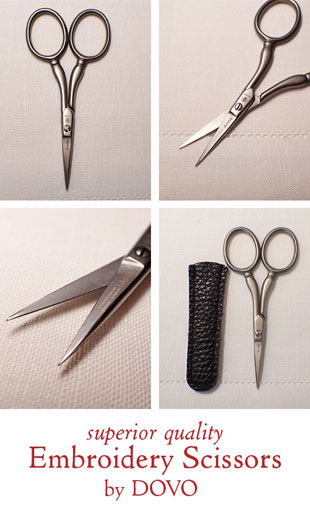

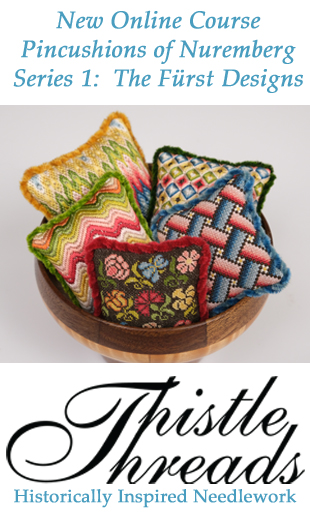
A timely article, Mary. I don’t often need to thread-park, but yesterday I was doing just that. I was working a border with stitches alternating in pink and blue. I found that it was easiest to leave the last front-to back motion of the pink stitch until after I’d worked the next blue stitch – again except for that last stage, which I completed when I needed the blue thread again. That meant that the threads out of work stayed on the front face where I could keep an eye on them, and it avoided threads getting caught in the stitches at the back. It’s not possible to do this with every type of stitch, but where there’s a final movement that can be left unworked until the same thread is needed again, it makes good sense.
Thread parking…such a great idea! I am not, nor ever have been, a thread parker, but I believe I might be doing this from now on! I usually just end the thread, mostly so I don’t confuse myself. Currently, I am working on a project on a more open weave linen with lots of different colors, so I believe I will start parking my thread as I continue on the piece. Plus, you make it sound so easy and like no big deal! 🙂 You have won me over on this!
So how do you “unpark” it?
Often, if you hold the needle so the eye is toward the fabric, and gently pull the thread from below and keep it all gently snug and as much straight up and down, you can pull the needle backwards (eye first) through the same hole. Whenever I try to stitch back through the hole, I usually manage to go through the thread and end up with a knot. Sometimes I have to unthread the needle, pull the threads to the back and re-thread.
Thank you, Gail. I hadn’t thought about unthreading the needle (the obvious solution). lol
Yes, I’m a parker! If I am working on a fabric that will show needle holes, sometimes I will park in an unstitched part of the design where any needle marks will be covered by stitches when I get to that part. I tend to leave needles in and catch them into the fabric outside the design area but like you, I spread the threads around to avoid chaos.
Thank you for doing this article. I know about parking when it comes to cross stitch but wasn’t sure how well it worked for embroidery. I’ve done very little parking, not with a lot of colors. Some people I know leave the needles on each color and park the needle right outside the edge of the fabric.
And when you come back to a color, do you run the thread under stitches on the back to tack them down and avoid stringing long threads across?
Thank you! I had never heard of this technique. And I’m in awe and a little jealous of your perfect little french knots. Mine always come out wonky.
Why don’t you just use all the purple first in the design, then all the yellow, etc. instead of changing colors?
I often, if it won’t wreck the thread, park the thread with a little stitch (down and up about 1 inch or less apart). This enables me to use the needle again if I need to and also stablizes the thread so it doesn’t wiggle around. Also keep the tails on the top of the fabric so you know where they are at all times.
This is brilliant – I’d never thought of parking my threads like that!
wow what a great idea..i did notknow abut this but am going to use it
thanks for the great tip
This is regarding the yellow French knots. I see you’ve done yours first. I always do mine last, since it seems less likely to mess them up that way. Did you make your knots first on this design to mark where the flowers were, or do you frequently make them first?
Most definitely! Is there any other way to work??
I learned a fantastic way to park a thread when I was at an embroidery retreat. You pull the thread out of the fabric away from the stitching area right beside a pin or needle placed on the fabric. Then you wind the thread around the pin/needle in a figure 8, the same way sailors wind rope around a cleat on a boat. It is so neat and tidy, and I just love this trick!
Anya, what a great idea. I never thought of that. If you use multiple needle minders the magnets get very heavy. This fixes the problem completely.
Never heard of parking u til today. I always used multiple needles. Always had tangled mess and then the colored thread would get confusing. I am so glad I read about this today. I just started embroidering 12 floral baskets for a quilt and this will make embroidering them much more simple. As usual you rock. Mary! Thanks
I have never “parked” my threads – was never taught to. But I sure will in the future! I have a couple of cross stitches going with lots of colors in bits and pieces, and this sure will make it easier since I won’t have to constantly end and restart threads. Thank you sooooo much for this article!!!!
I don’t often use a lot of colors when embroidering, except for needle painting. I’ll park threads by just sticking the point of needle off the design area inside the hoop. I tend to use several needles at once, one for each color. Sometimes I’ll put the needle in the fabric outside the hoop and wrap the thread around it, if there’s enough thread. I never use needle minders, I just don’t find them useful.
Hi Anya: This is the way we are taught at our guild, too. It looks so much tidier than having several threads dangling. And if you are ever stitching in public, people will always comment on how you neat you arrange your threads. Eunice M.
What a good article Mary. I park my threads I use a needle rest, sometimes a couple one each side of my work, depending where I am working, but I do have to take care as a small needle can be knocked off the rest while concentrating on another area, but if left parked in the fabric outside the working area it’s easy to accidently stab oneself while stitching and run the risk of bloodying your work.
Yep. I do park the threads. I found an article when I was looking for tips in cross stitching a design that has multiple shades of a color scheme (similiar to needle painting) through-out the piece. Although I found it hard to believe, it is a time saver. I tried keeping the needles threaded with and without a needle minder or magnet. I’m not sure about the magnet/needle minder yet. I like to keep the needles threaded because it seems more efficient in that the needle is ready to go. However, it seems that if I need to put the piece down without stitching for a period of time (yee God’s, darn I do have to do that!) it’s best to remove the needles. That was one big mess. Tangles don’t seem to happen when the parked threads are without needles and fanned out a bit around the fabric. That’s the way I do it with surface embroidery. Thanks for posting all the comments. I enjoy learning from everyone on N&T.
I’m fairly new to embroidery so I’m still learning tips and tricks (what a great day it was when I found this site!). I’ve never heard of thread parking before, but I’ll definitely be using it from now on!
Thanks for all the helpful tips and tricks.
I sure hope to see a pattern for these. The parts I see are sooooo pretty. As long (many years) as I have been embroidering I have never thought to “park” my needles. Never heard of it before. What a great idea.
Smiles to you
Linda
Thanks for a wonderful article. I had never heard of parking threads – or maybe calling it that. I have done much more cross stitch than embroidery. I’ve always finished off a thread(s) and then started a new one(s). It’s usually not as obvious on cross stitch yet can be an issue when there are many color changes in a small area. It can tend to leave a “bump” on your work. This is a great tip and I appreciate being able to see the thread parked on the top, not on the bottom.
I don’t often have a need to park threads, but when I do I park them. I’ve generally done so without the needle, spreading them around the work enough, but I like the idea of using a needle minder. If the minders are small (as mine are) you could use more than one to prevent chaos. Coming at the needle minder from different directions would also help, e.g. as though it were the center of a compass with different threads coming from different points.
I haven’t had to park much, so I like to use needle minders when I can. But it’s true they can really get in the way. Of course, any of that is better than the messes I’ve had on the back of my fabric when I didn’t park the thread.
Thanks so much for the tips, Mary.
Good golly, I’ve done that for years but always thought I was lazy/cheating by not properly finishing a thread! I’d even make sure there were no guilty threads showing if I was taking a project to stitch on at an EGA meeting.
Thanks so much for this tip. I know so very little about embroidery that I never knew about parking thread, nor even what a needle minder is.
Silly question, but why not have the hoop itself be magnetized as a needle minder somehow.
Hi Mary,
What is a reasonable distance if you are going to jump to the next place where that color is used?
thanks!!
wonderful idea…will try it next time i do embroidery
tnx
I am a needle parker. If, like what I’m doing now needs a frame and my two hands – when the length of thread I’m using is nearly finished and I’ve got more stitching to do in the same colour, I park my thread without ending (because turning over etc.) then, when this area is finished, I turn the work and tidy up/end all the threads one by one. Find it easier that way.
I often park my threads when working, but have another little trick too which works in some circumstances. If I have a thread parked which will be used further away, especially across an open area that will be filled with the new colour, I will choose to park it so that as I work the new colour, I catch down the parked thread behind my work with the new colour stitches. The finished result on the back looks as though I have run it through to its new position as normal. You do need to keep the parked thread taut for this to work.
Sounds like a conspiracy against embroidery beginners! I am a self-taught (books, internet) embroiderer and never ever saw any mentionings/tutorials about the parking technique. Subconsciously I always suspected about its existence and did cautiously park 2-3 colours at a time, almost looking over my shoulder :), but was too shy to admit it, as I thought it must be cheating and ‘professionals’ don’t do it!
Question to Anya Grey and Eunice M: winding the threads’ tails in an eight around a pin – isn’t it a bit dangerous as you can prick your fingers or get your sleeves caught on the pins’ tips? Do you tuck the pin’s tip back into the fabric after you ‘cleat’ the thread around it?
Sometimes I do, it all depends on the project, more often in surface embroidery than cross stitch.
I have no tips, but I sure do appreciate these and will be using them in future. Thanks again for the needle minder tip too, I never thought of doing that and threading needles with 72 y o eyes is tedious.
I also wanted to thank you for the tutorial on the fly stitch leaves. It came just in time to use them on the Oyster stitch flowers and buds I’m using on my crazy quilt seam. Works perfectly! Deonia in Florida
I usually use a needle minder. I have been doing cross stitching on a large project which I have on stretcher bars. I usually put my needle minder in the upper right corner next to the bar. That’s well away from the area where I’m working. If I know I well need a thread in another area, I put the needle through the fabric in the direction where I will need it, and wind the excess thread around the needle.
I prefer not to have to do this as inevitably I mess things up and have threads caught under other threads and generally a big mess. But I did learn a trick from my mother the dressmaker. When she gathered fabric for a skirt she would sew the two rows of stitching, then put in a pin vertically at the end of the stitching and wind the thread around the pin. Kept it neat and out of the way while she pulled from the other end. So now if I have to park threads, I leave the thread in the needle, bring it out on the right side so I can see where it is, and then take it beyond the stitching area and ‘pin’ it through the fabric and wind the excess thread around the needle. This seems to work quite well, although you do have to watch where you put your hands or you get the odd scratch or two from the needle points.
And now I have just had a quick look through the other comments and find that someone else uses this method. Ah well…c’est la vie.
Yes, I think the pins / needle winding is a good idea – but admittedly, I never take the time. I usually just hold the threads out of the way with my hoop-holding hand (if I’m working with a hoop) or smooth them off to the side when working on a frame. As long as they are brought to the front away from the stitching path, it works out pretty well without making a mess. If they are left on the back, that’s when I end up with a muddle!!
That’s a really good thing to know, thanks!
Thanks for the tip. I have usually left the needle threaded but this method is worth a try. Working on Mountmellick on tightly woven cotton and different weights of white thread will take some thought.
Thank you! this is hugely helpful.
Once you’ve parked your light purple and yellow threads and are finished working with the dark purple thread, and want to work with one of the other two, I assume you park the dark purple thread if you’re not finished with it, and then what? I assume you have to pull the saved thread from the front to the back and rethread it in your needle so you can continue stitching with it.
Hi, Linda – that’s correct. Or if you’re finished with it, just leave it and finish it through on the back when you’re ready to finish all the threads.
Some stitchers make a Rhodes stitch on the surface in which to park and secure threads…